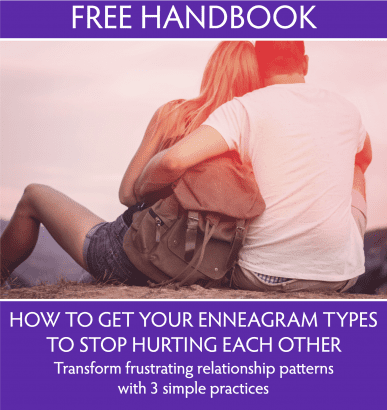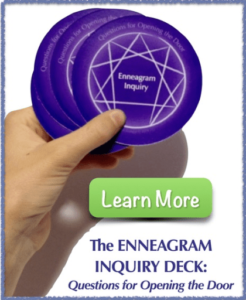As powerful as it can be to learn about your enneatype, it can be confounding to know how to do things differently. While the promise of the Enneagram is great in opening doors beyond “who we take ourselves to be,” the path of transformation is at least paradoxical, and can be downright grueling.
At first glance, our egos like the idea of more freedom, power, peace, etc. It sounds really good to live from the best of my type and get to have all the other eight strengths at my disposal. Indeed, when this actually happens, we often feel truly in the flow of the heart of life.
So of course we can say we want it. We just don’t typically choose to enter the territory that supports its happening. In fact, our personality is often built to keep us very far away from this territory. We like the idea of it— if only we don’t have to take the path to get there.
As a Three, for example, I might want to learn to let go, and not steer everything so that I feel approved of. I’d just like to manage the process in a way that doesn’t drop any balls or have me risk losing face. Hmmm.
Or at Six, I may be reading this post to understand exactly how to get to the destination without any pitfalls. If I get these “three keys,” then I’ll know how to travel safely and not have that existential fear come up again.
To tell the truth, we often actually don’t know how to “do the work.” What do we mean by “the work” anyway? Do I try to undo my type? Should I work hard to improve myself? Should I be vigilant against my weaknesses? Can I transcend my “lower” self? Shall I simply accept my type and celebrate when my gifts are shining?
It is natural to try any or all of these approaches. Inner work with the Enneagram, however, does not typically mean identifying more strongly with our types. It means developing skill in paying attention to how our types show up and how they try to determine our experience. It means cultivating a different kind of consciousness than our default inner radio station usually broadcasts.
Eckhart Tolle said:
“Trying to become a good or better human being sounds like a commendable and high-minded thing to do, yet it is an endeavor you cannot ultimately succeed in unless there is a shift in consciousness…. You do not become good by trying to be good, but by finding the goodness that is already within you, and allowing that goodness to emerge. But it can only emerge if something fundamental changes in your state of consciousness.”
The way to loosen the inner bonds that we inevitably experience is not by following what the ego imagines would feel good. Most often, it is through learning to be present with what is arising in the moment, and remaining with ourselves there with curiosity and compassion. When we find our way there, something fresh can unfold.
OK, that sounds good, but as anyone who practices mindfulness, meditation or prayer knows, this can take tremendous discipline. Inner work includes being present with the things we appreciate in ourselves, and all the things our personality would like us to steer away from. Really far away from.
As I see it today, there are three keys to being able to travel this road in a way that bears fruit. They are:
- Cultivating awareness
- Responding to reactivity
- Getting curious
This post will offer an overview of these three keys for inner work. The following three posts (Parts 2-4 of the series) will cover each of these three in more detail.
Cultivating Awareness
Self-awareness is a topic on which I don’t claim to be an expert. I’ll leave the teaching to the Buddha and other masters. I am a student, though, and find several things important in developing my ability to use awareness to help loosen my identification with my Enneagram type.
Without awareness, we simply follow our nature, instincts and conditioning. It can be almost relaxing, in a way, to be on autopilot. Except for when my autopilot smacks me into things. Except for when I begin to see that it is doing this every day in predictable ways.
Like for type One, where the harder I try to be good, the more frustrated I become with the world. Others begin to seem more pathetic as they criticize me for my passionate striving. When do I get to that good part?
As we develop, we begin to see how our programs set us up for suffering (in at least nine distinct ways), and we begin to be interested in whether there is another way to live. Our suffering can potentially lead us into rich territory, healing, and awakening. It is unlikely we will find our way through it, however, without the “shift in consciousness” Tolle speaks of.
Generally, such a shift is not possible without developing an “inner observer.” This is a term used in Enneagram work for a state of consciousness we all have access to. It is an innate ability to be in the present moment and see things plainly as they are. It is distinct from much of our inner commentary which is loaded with narrative, critique, and strategy. It is being with my personal experience without being defined or consumed by it. When I’m in this stance, I don’t assume that my sensations, thoughts, and emotions are the truth, neither do I indulge or reject them. I stay with myself in my experience of them. I am awake to my experience in the moment.
This shift might play out in a Seven who has been paying attention to her type in action. When things feel uncomfortable in her primary relationship, she often tries to pep talk her partner about taking a positive approach, or to distract with pleasure. As she observes the effect of this strategy operating— how her partner tends to withdraw, and how she herself begins to feel both desperate and angry—- it occurs to her to pause, to breathe, and to connect with herself in the moment before acting further.
There are simple and powerful ways to strengthen the muscle of this way of paying attention. I will share more about this with you in Part 2 of this series.
Responding to Reactivity
Simply put, reactivity is when our buttons get pushed. We react strongly and quickly to something based on our experiences, conditioning, and fears.
Often, reactivity feels “hot,” with strong emotions or raised voices. It can also be less outwardly expressive through withdrawal, disassociation, or avoidance. Ultimately, our pain, fear, and defenses power up, and we don’t tend to think or act in a reflective or creative way.
We all get reactive. As a Nine, it looks to others often as though I don’t. My personality style dictates that I remain calm and even-keeled, even when I’m in great distress. In fact, when I’m most upset, my face and voice can seem impassive.
A Two may seem “hot” in reactivity at times, chastising his loved ones for not appreciating his service; he may alternatively seem extra sweet and pleasing in his reactivity when insecure.
Once we have some capacity for inner observation, working with our reactivity is a crucial place to bring our attention. Once we notice that we are triggered, how we respond to ourselves makes all the difference.
A common unconscious response we have is agreeing with our inner reactions. As a Four, when I feel excluded or like I don’t belong, I am likely to feel there is something wrong with me. When I feel this, I believe it, and I start to have other thoughts and feelings in reaction to being wrong or rejected (anger, despair, longing, resolve, etc.).
Another common unconscious response is rejecting our inner reactions. As a Five, when I feel needy, I will likely want to stop that feeling as soon as possible. No one prefers to feel needy, but at Five, I’m particularly allergic to it. So, I’ll either block it out, or do something to feel my resourcefulness, countering the feeling of need.
Rather than agreeing with or rejecting our reactivity, there is the option of meeting myself right there in it. What would it be like if I could accompany myself through that tight and difficult spot? Beginning with the non-judgmental stance of the inner observer, I could stay grounded in the present moment and notice my body sensations, my thoughts and emotions. I could be sweet to my poor old self for experiencing those classic buttons again. I could bring my presence in close, like that of a dear friend, abiding with all that is arising in me.
There are specific ways to invite this possibility that truly open us to a different way of being. I will discuss these more in Part 3 of this series.
Getting Curious
When we are on autopilot, or are in a reactive state, we are typically not very curious. At most, we are interested in how to return to our comfort zone as quickly as possible.
When my observer is present, curiosity is second-nature. When I’m present and grounded, and compassionately responding to my experience, I become able to explore new territory within me.
Without curiosity and openness, we are likely to choose our same well-worn grooves time and again. At Eight, getting curious can sometimes feel very vulnerable. It may more comfortable for me to stick with what I know to be true.
It can take courage to choose to follow this kind of curiosity- as it’s different from analyzing and explaining. It can feel risky when I want to explore myself directly and honestly. I might learn things about myself that my identity disapproves of. I might find I’m much more than I’ve taken myself to be.
Curiosity and self-inquiry can be cultivated. I will share ways to do this in Part 4 of this series.
With experience invoking these three keys for inner work, you are likely to find yourself stumbling upon what Tolle calls “the goodness that is already within you.” And it follows that as you come to understand your nature as made of that goodness, it will become easier to want to stay awake, to come close in, and to be brave to investigate what’s wanting your attention next.
Which of these three is most available to you? Which is the hardest for your type? Share your comments below.
Part 1: Introduction – THREE KEYS FOR INNER WORK
Part 2: Cultivating Awareness
Part 3: Responding to Reactivity
Part 4: Getting Curious










4 Responses
Love the concepts and ways your writing makes me think deeper. Looking forward to more! +A
>